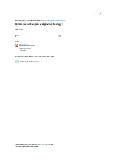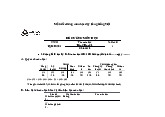






Preview text:
SEAT NUMBER: ……….… ROOM:..……………….
FAMILY NAME:………….....…………………………. This question paper must be returned.
OTHER NAMES:……..…….…………………..……..
Candidates are not permitted to remove any
part of it from the examination room.
STUDENT NUMBER:…..…….………..……………..
FORMAL EXAMINATION PERIOD: SESSION 1, JUNE 2016 Unit Code: ECON847 Unit Name: INTERNATIONAL TRADE Duration of Exam
2 HOURS (PLUS 10 MINUTES READING TIME)
(including reading time if applicable):
Section A: 20 Multiple Choice Questions (20 Marks)
Total No. of Questions:
Section B: 5 True and False Questions (10 Marks)
Section C: 2 Long Answer Questions (20 Marks) Total No. of Pages 7
(including this cover sheet):
GENERAL INSTRUCTIONS TO CANDIDATES:
• Candidates are required to obey all instructions provided by the Final Examination Supervisor and must refrain from communicating in any way
with another student once they have entered the final examination venue.
• Candidates may not write or mark the exam materials in any way during reading time.
• Candidates may only access authorised materials during this examination. A list of authorised material is available on this cover sheet.
• If it is alleged you have breached these rules at any time during the examination, the matter may be reported to a University Discipline Committee for determination. EXAMINATION INSTRUCTIONS:
Section A consists of 20 Multiple Choice Questions that MUST be answered on the Multiple
Choice CODE Sheet provided (20 Marks in total).
Section B consists of 5 True and False Questions. Students must answer all questions and
provide a very short explanation for each question in the answer booklet provided (10 Marks in total).
Section C consists of 2 Long Answer Questions. Students must answer ANY ONE question in the
answer booklet provided (20 Marks in Total).
AIDS AND MATERIALS PERMITTED/NOT PERMITTED:
Dictionaries: No dictionaries permitte d
Calculators: No calculators permitte d Other:
Closed book – No notes or textbooks permitte d
Section A: Multiple Choice Questions (20 Marks)
Answer ALL of the 20 multiple-choice questions. Questions are of equal value. For each
question select the one that MOST correctly answers the question. 1.
Mercantilists advocated a policy in which:
a) The government regulates all aspects of economic activity to a significant level;
b) The government interferes with economic activity to a moderate level;
c) The government keeps regulation of economic activity to a minimum;
d) The government’s interference in economic activity is completely non-existent. 2.
The concept of absolute advantage provides that the resources of trading partners are
utilized most efficiently, and that the output of both commodities will: a) fall; b) rise; c) stay the same; d) increase initiall y and then decrease. 3.
Most favoured nation (MFN) status means that a country treats another country
a) better than its other trading partners;
b) the same as its other trading partners;
c) worse than its other trading partners;
d) any way it chooses since it is the "most favoured nation." 4.
In many developing nations, _________ provide employment opportunities and
____________ to pay for the many products that cannot be produced in the home country. a) imports, earnings; b) exports, earnings; c) exports, outputs; d) imports, outputs. 5.
The ratio between a country’s imports and exports of goods or services to their gross
domestic product (GDP) is a measure of that country’s: a) microeconomics; b) openness as an economy; c) macroeconomics; d) economic interdependence. 2 6.
Japan is more efficient in the production of rice, and the United States is more efficient in the
production of oranges. In the production of oranges, Japan is said to have a(n): a) comparative advantage; b) absolute disadvantage; c) absolute advantage; d) comparative disadvantage. 7.
The marginal rate of transformation (MRT) of X for Y refers to:
a) the amount of X that a nation must give up to produce each additional unit of Y;
b) the amount of X that consumers are willing to give up to consume each additional unit of Y;
c) the amount of Y that consumers are willing to give up to consume each additional unit of X;
d) the amount of Y that a nation must give up to produce each additional unit of X. 8.
When countries engage in international trade, specialization tends to be:
a) complete with constant costs, and complete with increasing costs;
b) incomplete with constant costs and incomplete with increasing costs;
c) incomplete with constant costs and complete with increasing costs;
d) complete with constant costs and incomplete with increasing costs. 9.
As we consume more of a commodity, a (n) ______________ marginal rate of substitution in
consumption is reflected in a ________ community indifference curve. a) increasing, convex; b) declining, convex; c) increasing, concave; d) constant, convex.
10. The point of tangency between the production possibilities frontier and community indifference curve reflects:
a) the nation’s comparative advantage;
b) internal equilibrium relative to commodity price in the nation;
c) external equilibrium relative to commodity price in the nation; d) Both (a) and (b).
11. Which model states that a nation can shift from being a net exporter of a good to a net importer of the same good? a) Specific-factors model; b) Technological gap model; c) Product cycle model; d) Real business cycle model. 3
12. Which of the following states that the difference in relative factor abundance and relative
factor prices is the cause of the pre t
- rade difference in relative commodity prices between two nations? a) Stolper-Samuelson theorem;
b) Differentiated product theorem; c) Heckscher-Ohlin theorem; d) None of the above.
13. Assume the cost of transporting computers from US to Japan is greater than the pre-trade
price difference for computers between US and Japan. Trade in computers between US and Japan will:
a) be very profitable for both parties;
b) be a breakeven proposition for both parties; c) occur; d) not occur.
14. When a specific tariff is used instead of an ad valorem tariff:
a) higher priced goods enjoy a greater degree of protection than cheaper goods;
b) domestic consumers are encouraged to purchase cheaper goods;
c) cheaper goods enjoy a greater degree of protection than higher priced goods;
d) domestic producers enjoy a greater degree of protection in periods of rising prices.
15. Strategic trade policy is concerned with protecting, and assisting in creating comparative advantage in: a) agricultural commodities;
b) transportation related industries; c) national growth a - ffecting industries; d) unskilled labour i - ntensive industries.
16. The more _____________ the demand or supply curves of the imported commodity in the
nation imposing the tariff, the more likely it is that a large nation will experience a net welfare gain from the tariff. a) inelastic; b) elastic ; c) linear; d) non-linear; 4
17. As a result of their high farm support price level, the EU has experienced:
a) high agricultural surpluses, high storage costs, and subsidised exports;
b) low agricultural surpluses, and low storage costs;
c) non-subsidised exports among the agricultural industry;
d) economies of scale in agricultural.
18. Which of the following is one of the three main advantages of an import-substitution industrialization strategy?
a) The market for the industrial product already exists, as evidenced by imports of the
commodity, so that risks are reduced in setting up an industry to replace imports;
b) It overcomes the smallness of the domestic market and allows a developing nation to
take advantage of economies of scale;
c) Production of manufactured goods for export requires and stimulates efficiency throughout the economy;
d) The expansion of manufactured exports is not limited by the growth of the domestic market.
19. Which of the following approaches to exchange rate determination argues that the exchange
rate is determined in the process of equilibrating the total demand and supply of the national currency in each nation?
a) The purchasing-power parity theory;
b) The monetary model of exchange rates;
c) The trade approach to exchange rates;
d) The elasticities approach to exchange rates.
20. If the value of a country’s imports is greater than the value of its exports, the domestic
currency is expected to depreciate and trade adjustments start taking place. Under this
situation how does the employment of resources affect the amount of currency depreciation
required to shift domestic resources to the production of more exports and import substitutes?
a) The greater the employment of resources (i.e. a lower unemployment rate) the greater
the depreciation of the nation's currency is needed
b) The greater the employment of resources the less depreciation of the nation's currency is needed
c) The size of the employment of resources has relatively little influence on the amount of
currency depreciation needed, as there is a loose relation between the two
d) The employment of resources only plays a role for the large economies and has no
influence for smaller economies 5
Section B: True and False (10 Marks)
You are to answer ALL questions. You are to provide a SHORT explanation in the ANSWER
BOOKLET provided. Answers WITHOUT any explanation will be awarded a mark of zero.
NOTE: YOUR ANSWERS MUST BE WRITTEN IN THE ANSWER BOOKLET PROVIDED.
PLEASE DO NOT WRITE YOUR ANSWERS ON THIS EXAMINATION PAPER. 1.
If an economy is characterised by increasing opportunity costs, increasing the production of
S by constant amounts results in a constant cost decrease in the production of T. (2 Marks) 2.
The major economic problem with positive externalities is that the actual market outcome is
always above the optimal level of output. (2 Marks) 3.
The absolute value of the slope of the production possibilities frontier at the production point
provides a measure of both the relative price of S in terms of T and the opportunity cost of
producing one more unit of S calculated in terms of output of T foregone. (2 Marks) 4.
Immiserizing growth is the situation in which the contraction of a country's exporting industry
results in a reduction in the world price of the exported good and an increase in the
economic welfare in the exporting country. (2 Marks) 5.
Countries that grow the slowest are those that have typically adopted inward-oriented
policies toward trade and foreign direct investment. (2 Marks) 6
Section C: Long Answer Questions (20 Marks)
Students are to answer ANY ONE question in the ANSWER Booklet provided. Question 1: (i)
The classical model predicts that countries will completely speciali e s in the production of
their comparative advantage good. Explain why the opportunity to engage in
international trade would lead to this result. (Use correctly labelled diagrams; 6 Marks ) (ii)
What is the index of openness? Economists express four (4) major concerns over the
use of trade sanctions (i.e. barriers) in enforcing standards (i.e. labour and
environmental). Explain (6 Marks) (iii)
What is the effect on the exchange rate of an increase in the nation’s money supply
according to the monetary model? What is the relative purchasing power theory? When
do we expect it to hold and not to hold? (8 Marks) OR Question 2: (i)
Compare and contrast the Classical and Heckscher- Ohlin theories of the commodity
composition of trade. Discuss the differences in assumptions, post-trade production
points, and the effects of trade on the distribution of income. (7 Marks ) (ii)
What are the arguments for and against protection? E
xplain why overshooting occurs in
exchange rate models. (7 marks ) (iii)
Explain the difference between a customs union and a free trade area. Explain how a
custom union may have both trade creating and trade diverting effects. What are the
dynamic benefits which are said to flow from the formation of a custom union? (6 Marks) 7




